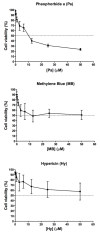Hypericin and Pheophorbide a Mediated Photodynamic Therapy Fighting MRSA Wound Infections: A Translational Study from In Vitro to In Vivo
- PMID: 34575478
- PMCID: PMC8472478
- DOI: 10.3390/pharmaceutics13091399
Hypericin and Pheophorbide a Mediated Photodynamic Therapy Fighting MRSA Wound Infections: A Translational Study from In Vitro to In Vivo
Abstract
High prevalence rates of methicillin-resistant Staphylococcus aureus (MRSA) and lack of effective antibacterial treatments urge discovery of alternative therapeutic modalities. The advent of antibacterial photodynamic therapy (aPDT) is a promising alternative, composing rapid, nonselective cell destruction without generating resistance. We used a panel of clinically relevant MRSA to evaluate hypericin (Hy) and pheophobide a (Pa)-mediated PDT with clinically approved methylene blue (MB). We translated the promising in vitro anti-MRSA activity of selected compounds to a full-thick MRSA wound infection model in mice (in vivo) and the interaction of aPDT innate immune system (cytotoxicity towards neutrophils). Hy-PDT consistently displayed lower minimum bactericidal concentration (MBC) values (0.625-10 µM) against ATCC RN4220/pUL5054 and a whole panel of community-associated (CA)-MRSA compared to Pa or MB. Interestingly, Pa-PDT and Hy-PDT topical application demonstrated encouraging in vivo anti-MRSA activity (>1 log10 CFU reduction). Furthermore, histological analysis showed wound healing via re-epithelization was best in the Hy-PDT group. Importantly, the dark toxicity of Hy was significantly lower (p < 0.05) on neutrophils compared to Pa or MB. Overall, Hy-mediated PDT is a promising alternative to treat MRSA wound infections, and further rigorous mechanistic studies are warranted.
Keywords: hypericin; methicillin-resistant Staphylococcus aureus; photodynamic therapy; wound infection model.
Conflict of interest statement
The authors declare no conflict of interest. The funders had no role in the design of the study; in the collection, analyses, or interpretation of data; in the writing of the manuscript, or in the decision to publish the results.
Figures












Similar articles
-
Monosubstituted tricationic Zn(II) phthalocyanine enhances antimicrobial photodynamic inactivation (aPDI) of methicillin-resistant Staphylococcus aureus (MRSA) and cytotoxicity evaluation for topical applications: in vitro and in vivo study.Emerg Microbes Infect. 2020 Dec;9(1):1628-1637. doi: 10.1080/22221751.2020.1790305. Emerg Microbes Infect. 2020. PMID: 32619386 Free PMC article.
-
A Novel Dicationic Boron Dipyrromethene-based Photosensitizer for Antimicrobial Photodynamic Therapy against Methicillin-Resistant Staphylococcus aureus.Curr Med Chem. 2021;28(21):4283-4294. doi: 10.2174/0929867328666201208095105. Curr Med Chem. 2021. PMID: 33292110 Free PMC article.
-
Antibiotic-free nanotherapeutics: hypericin nanoparticles thereof for improved in vitro and in vivo antimicrobial photodynamic therapy and wound healing.Int J Pharm. 2013 Sep 15;454(1):249-58. doi: 10.1016/j.ijpharm.2013.06.067. Epub 2013 Jul 5. Int J Pharm. 2013. PMID: 23834835
-
Contemporary approaches and future perspectives of antibacterial photodynamic therapy (aPDT) against methicillin-resistant Staphylococcus aureus (MRSA): A systematic review.Eur J Med Chem. 2020 Aug 15;200:112341. doi: 10.1016/j.ejmech.2020.112341. Epub 2020 May 13. Eur J Med Chem. 2020. PMID: 32505848
-
Hypericin-Mediated Photodynamic Therapy for Head and Neck Cancers: A Systematic Review.Biomedicines. 2025 Jan 13;13(1):181. doi: 10.3390/biomedicines13010181. Biomedicines. 2025. PMID: 39857765 Free PMC article. Review.
Cited by
-
Susceptibility of Dental Caries Microcosm Biofilms to Photodynamic Therapy Mediated by Fotoenticine.Pharmaceutics. 2021 Nov 10;13(11):1907. doi: 10.3390/pharmaceutics13111907. Pharmaceutics. 2021. PMID: 34834321 Free PMC article.
-
Environmentally sensitive photosensitizers enable targeted photodynamic ablation of Gram-positive antibiotic resistant bacteria.Theranostics. 2023 Jun 26;13(11):3814-3825. doi: 10.7150/thno.84187. eCollection 2023. Theranostics. 2023. PMID: 37441588 Free PMC article.
-
Photodynamic therapy of cervical cancer: a scoping review on the efficacy of various molecules.Ther Adv Chronic Dis. 2024 Mar 4;15:20406223241233206. doi: 10.1177/20406223241233206. eCollection 2024. Ther Adv Chronic Dis. 2024. PMID: 38440782 Free PMC article.
-
Comparative analysis of antimicrobial compounds from endophytic Buergenerula spartinae from orchid.Antonie Van Leeuwenhoek. 2023 Oct;116(10):1057-1072. doi: 10.1007/s10482-023-01870-9. Epub 2023 Aug 19. Antonie Van Leeuwenhoek. 2023. PMID: 37597137
-
In Vivo Quantification of the Effectiveness of Topical Low-Dose Photodynamic Therapy in Wound Healing Using Two-Photon Microscopy.Pharmaceutics. 2022 Jan 26;14(2):287. doi: 10.3390/pharmaceutics14020287. Pharmaceutics. 2022. PMID: 35214020 Free PMC article.
References
-
- Cheikh A., Belefquih B., Chajai Y., Cheikhaoui Y., El Hassani A., Benouda A. Enterobacteriaceae producing extended-spectrum beta-lactamases (ESBLs) colonization as a risk factor for developing ESBL infections in pediatric cardiac surgery patients: Retrospective cohort study. BMC Infect. Dis. 2017;17:237–242. doi: 10.1186/s12879-017-2346-4. - DOI - PMC - PubMed
-
- Dubinsky-Pertzov B., Temkin E., Harbarth S., Fankhauser-Rodriguez C., Carevic B., Radovanovic I. Carriage of extended-spectrum beta-lactamase-producing enterobacteriaceae and the risk of surgical site infection after colorectal surgery: A prospective cohort study. Clin. Infect. Dis. 2019;68:1699–1704. doi: 10.1093/cid/ciy768. - DOI - PubMed
-
- Neyra R.C., Frisancho J.A., Rinsky J.L., Resnick C., Carroll K.C., Rule A.M. Multidrug-resistant and methicillin-resistant Staphylococcus aureus (MRSA) in hog slaughter and processing plant workers and their community in North Carolina (USA) Environ. Health Perspect. 2014;122:471–477. doi: 10.1289/ehp.1306741. - DOI - PMC - PubMed
-
- Yuen J.W., Chung T.W., Loke A.Y. Methicillin-resistant Staphylococcus aureus (MRSA) contamination in bedside surfaces of a hospital ward and the potential effectiveness of enhanced disinfection with an antimicrobial polymer surfactant. Int. J. Environ. Res. Public Health. 2015;12:3026–3041. doi: 10.3390/ijerph120303026. - DOI - PMC - PubMed
Grants and funding
LinkOut - more resources
Full Text Sources
Molecular Biology Databases
Miscellaneous

